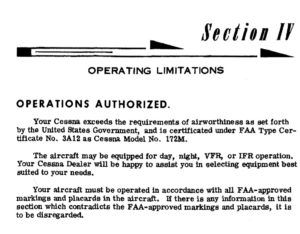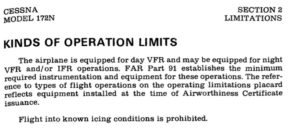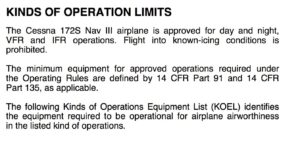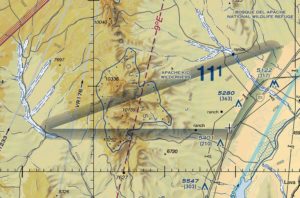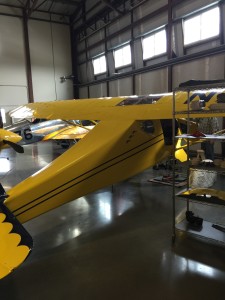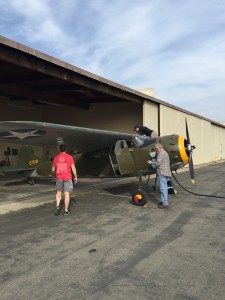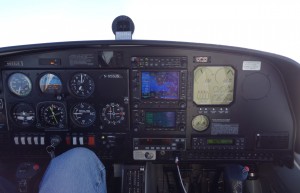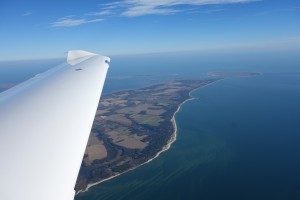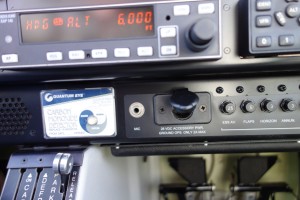I’ve been in the market for a tail dragger to add to On Course Aviation for a while. The goal is to offer tail wheel training required for a licensed pilot to receive the tail wheel endorsement and also to offer  sight seeing rides at WV77. While I love a tandem such as a J3 Cub, I like to instruct in a side by side airplane. I think I do a better job instructing when I can see what the student is doing and the student can see what I’m doing! At first I was thinking of something like a Luscombe, Aeronca Chief, or a Cessna 140 but I came around the C-170 because it offers a little more horsepower and space. Plus I’m a Cessna guy. I didn’t really want the 180 hp Lycoming conversion. The extra horsepower would be nice but it is also more gallons per hour and more weight. Plus I first soloed in a 1950 C-150 with a Continental engine and I think they just sound better than a Lycoming and I think the little six cylinder on the C-170 is cool. There were several C-170 authorized modifications (Supplemental Type Certificates) that I did want. One was Cessna 180 landing gear, which is a little more stout and raises the nose somewhat, and a Scott tail wheel. The Scott tail wheel is better than the original. So N2266D is the now a member of On Course Aviation!
sight seeing rides at WV77. While I love a tandem such as a J3 Cub, I like to instruct in a side by side airplane. I think I do a better job instructing when I can see what the student is doing and the student can see what I’m doing! At first I was thinking of something like a Luscombe, Aeronca Chief, or a Cessna 140 but I came around the C-170 because it offers a little more horsepower and space. Plus I’m a Cessna guy. I didn’t really want the 180 hp Lycoming conversion. The extra horsepower would be nice but it is also more gallons per hour and more weight. Plus I first soloed in a 1950 C-150 with a Continental engine and I think they just sound better than a Lycoming and I think the little six cylinder on the C-170 is cool. There were several C-170 authorized modifications (Supplemental Type Certificates) that I did want. One was Cessna 180 landing gear, which is a little more stout and raises the nose somewhat, and a Scott tail wheel. The Scott tail wheel is better than the original. So N2266D is the now a member of On Course Aviation!
Category Archives: Uncategorized
More Rusty Pilots
I’m presenting an AOPA Rusty Pilot Seminar at Weyers Cave, Virginia (KSHD) on 4 March 2017 starting at 9:00am. I have another in Buffalo, NY on 18 March also at 9am. These seminars have been a lot of fun and folks really seem to enjoy the presentation and the chance to gather with a bunch of “Rusty Pilots” who would like to get back into flying. To register or find a location follow this link or go to AOPA > You can fly (located at the top of the web page) > Rusty Pilots. The presentation provides a review of regulations and procedures and I’d like to think it would be a good review for anyone. I also provide all the attendees with an endorsement for the ground portion of a §61.56 flight review. So come on out! And if you can’t make one of mine there are others at locations all around the country. And did I mention that the seminar is free to AOPA members?
More on Rusty Pilot seminars
The Monadnock Aviation seminar at Keene, NH seemed to go very well. A total of 34 Rusty Pilots showed up and I hope they will now come back into the flying arena. Special thanks to Beth for hosting the Monadnock event. I have two seminars coming up. The first is hosted by Airborn Flight Services at Farmingdale, NY on 18 February and he second is at Weyers Cave, VA (Shenandoah Valley Regional Airport) on 4 March. Please come out and join your fellow pilots.
AOPA Rusty Pilot seminars
I recently became a presenter for the Airplane Owners and Pilots Association (AOPA) Rusty Pilot Seminars. These seminars provide training that meets the requirements for the ground portion of a §61.56 flight review and are intended to get pilots that have been out of flying for a while back into flying. Many factors cause pilots to lapse in their flying; time, family requirements, and money are just a few. Some have been away from flying for a few years while others many have been away for many. I’m a member of a rather large flying club in Virginia. In the last few years we have had several folks join the club who have been out of flying for quite a while. One received his Private Rating in 1980 but family requirements soon caused flying to fall off the priority list. I provided instruction to get him back into flying – many things had changed (GPS, Airspace, headsets!) but many things are the same (they are still airplanes after all). He is now actively flying and having a blast. These “Rusty Pilots” spoke of how they needed a “nudge” to get back into flying. Where to start? Who to talk to? This is goal of AOPA’s Rusty Pilot program, to help get folks back into flying. So, if you happen be a Rusty Pilot (or know of one) go to the AOPA web site to look for a presentation in your area. My first presentation will be at Monadnock Aviation in Keene, NH (EEN) on the 21st of January, 2017. Hope to see you there!
Finding Instrument Approach non-standard alternate minimums in ForeFlight.
It is authorized, legal, and just fine to use ForeFight for a pilot evaluation but you must know how to find the information you need for the flight. An area that causes difficultly on Instrument check rides is finding non-standard Alternate minimums (also non-standard Take Off minimums). These are noted on an approach plate with a “negative” T or A in the remarks section. Note the “T” an “A” just below the WAAS section for the RNAV approach in Suffolk.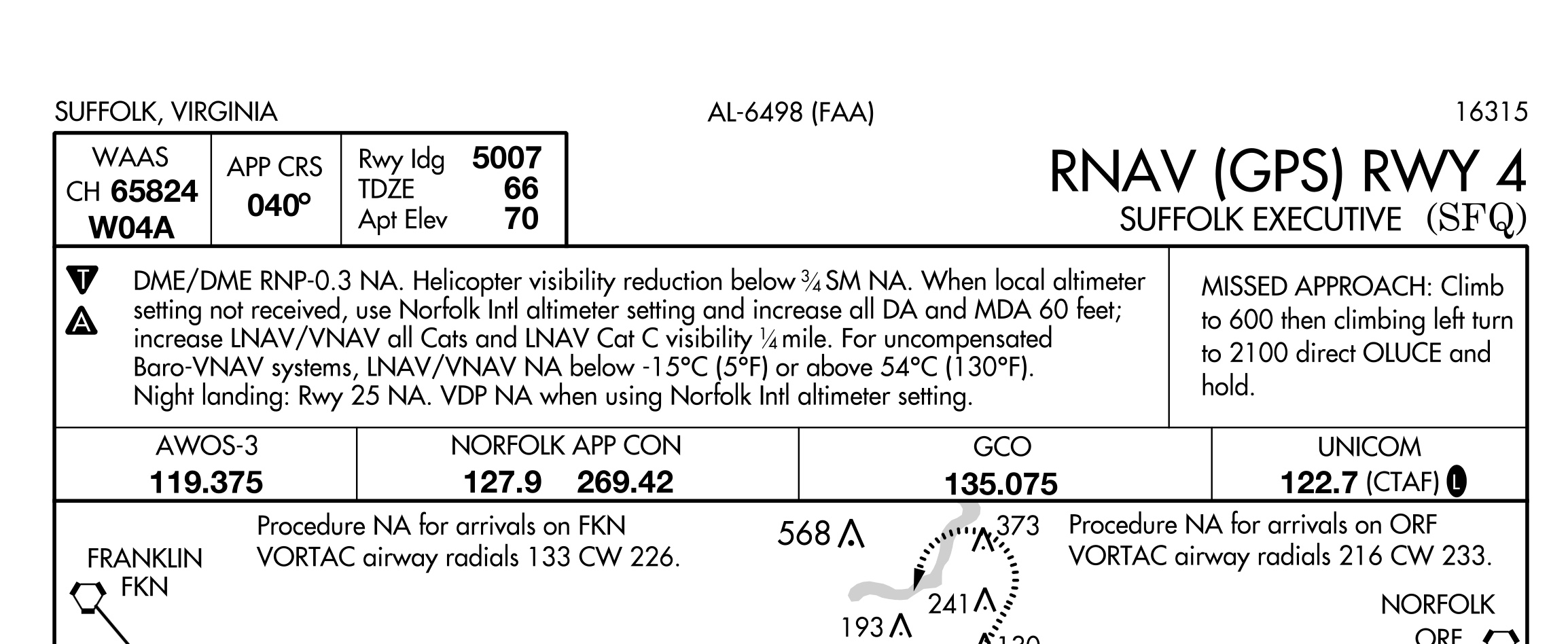
To find this information (in this case non-standard Alternate Minimums) first go to the airports section and click on the tab for Procedures.

Next go to the Arrival section and select Alternate minimums.
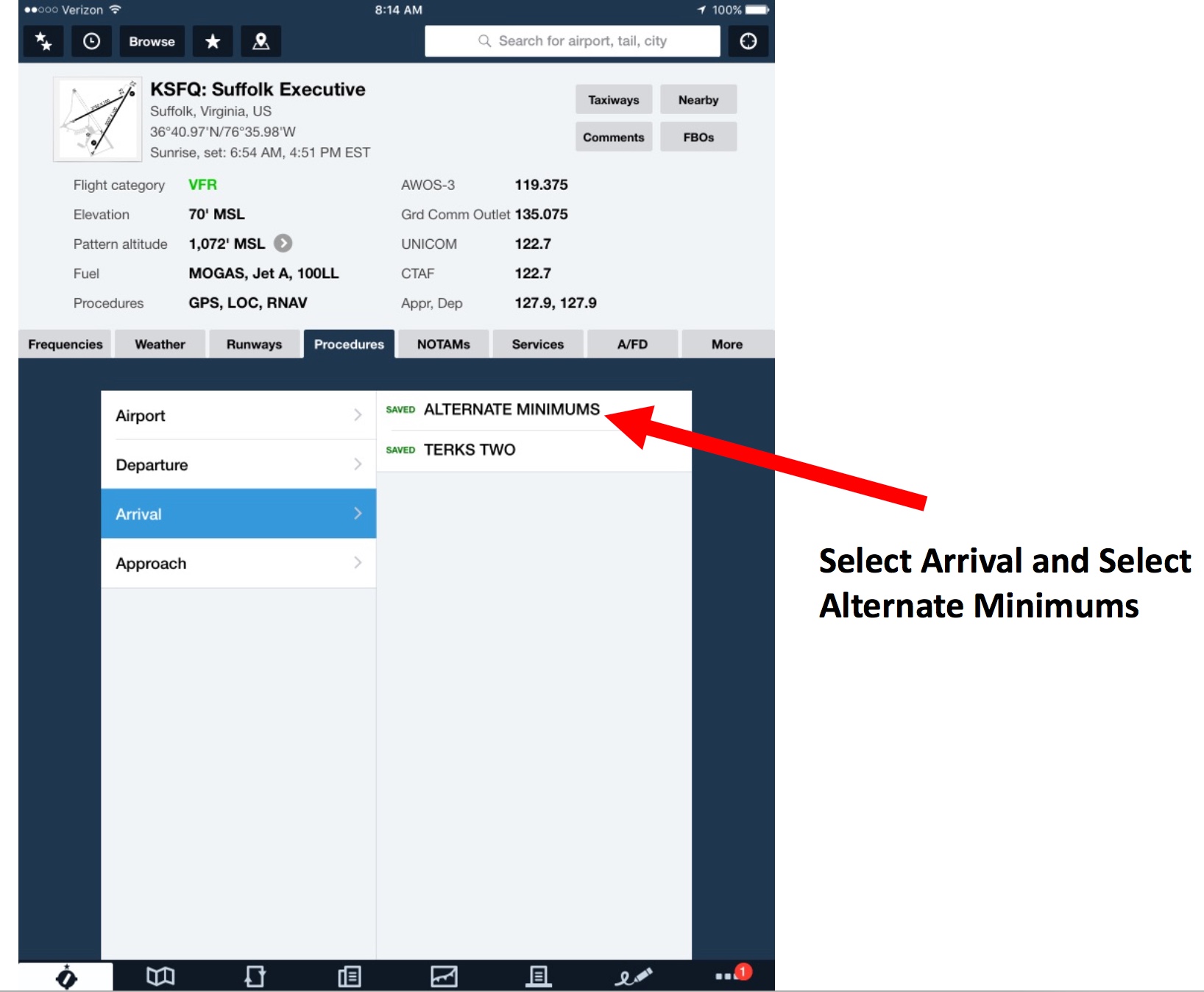
This will take you to the non-standard Alternate minimums that would be in the front section of the hard copy Terminal Procedures (Approach Plate) publication. These are all available online but I find that pilots are very familiar with getting the airport approach but are at a loss to find the non-standard alternate minimums. BTW, non-standard take off minimums are in the departure section of the Procedures tab. While this is a very simple task it is easily overlooked.
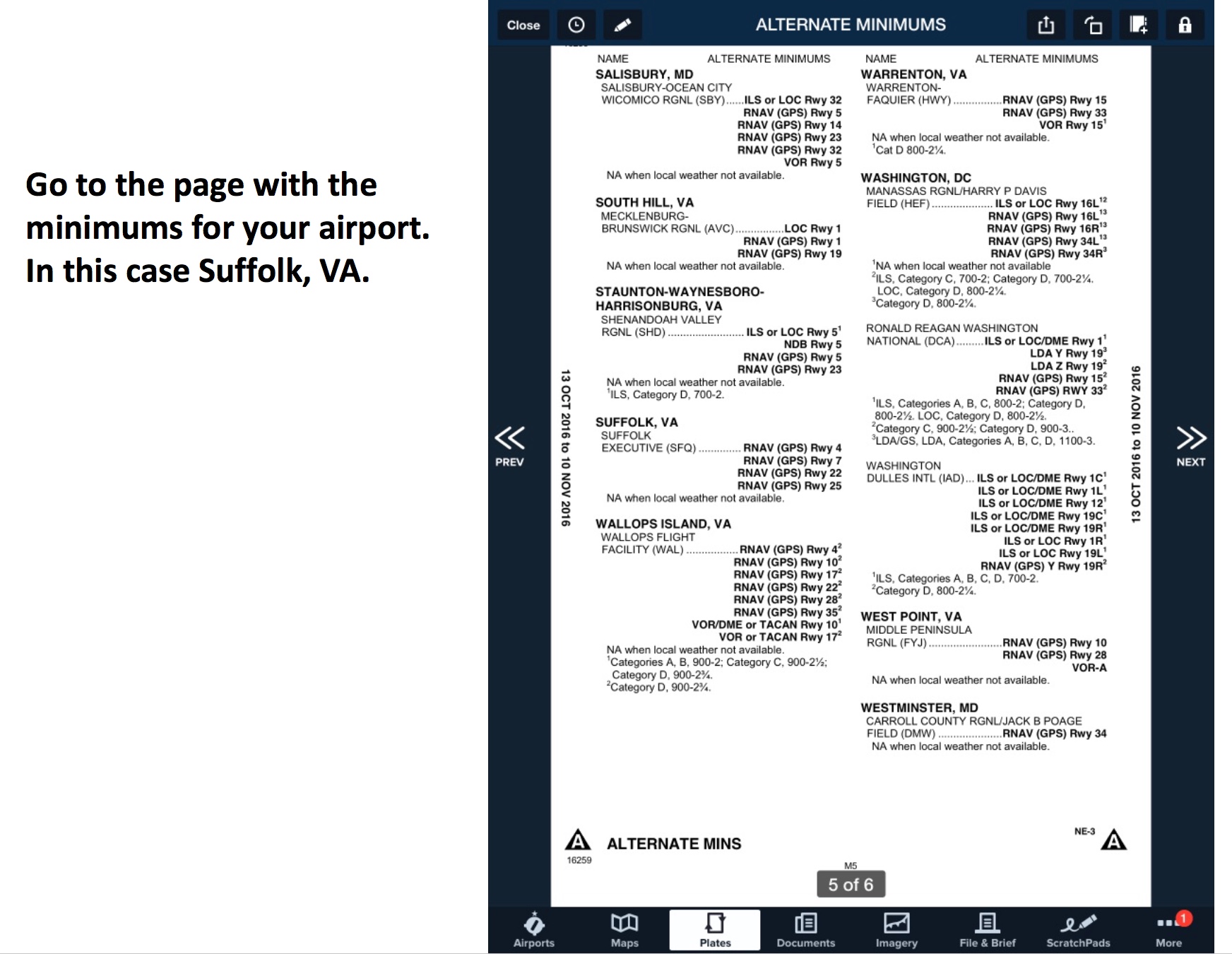
SIGMETS and AIRMETS
SIGMETS and AIRMETS seem to be misunderstood by many applicants. Private, Instrument, and Commercial applicants should expect to be asked about both and with a little review these are pretty easy. SIGMETS consist of Convective SIGMETS and “the others”. AIRMETS consist of three types, Tango, Sierra, and Zulu. A great summary is on the Aviation Weather Center (AWC) web site.
100LL
What color is 100LL and why do we use it? 100LL contains tetraethyl lead while you use unleaded fuel in your car. Why? Lead prevents detonation and an applicant for a pilots certificate (license) should have some knowledge of what detonation is and why we are concerned about it. 100LL is blue and Jet Fuel (commonly Jet A) is the color of straw. I’m surprised that many folks think the “Jet Fuel” is some super high octane fuel. Jet fuel is basically kerosene and can be used in diesel engines. If you put jet fuel in your piston engine airplane the engine will not run for long and this contamination has caused many serious accidents. So your fuel is blue to help you determine if it has been contaminated, especially by jet fuel. And the subject of fuel leads to engines. You are not required to know how to build a piston engine for a private pilot check ride but you should have an idea of how it works, what makes it run, and what makes it not run.
Can you fly the airplane if something is not working?
Most applicants are familiar with the items listed in §91.205 (remember “TOMATOFLAMES” anybody?). As pilots we are taught early on that the equipment listed in §91.205 must be operational. But what happens if something not listed in §91.205 is inoperative? A dated but still valid guiding document for this dilemma is AC 91.67. This AC discusses the use of a Minimum Equipment List (MEL). A MEL solves this problem by providing guidance as to what must be done (or what you can do) if some component not listed in §91.205 is inoperative. But what to do if your airplane doesn’t have a MEL? Check out chapter 2 of AC 91.67. Chapter 2 provides a step by step guideline for what the pilot must do to ensure the airplane is both safe and legal to fly. The first step is to check the equipment list or “kinds of equipment” list. Here are some examples of a “kinds of equipment” list:
The example above is from a C172M POH and is not very specific. Note that there is no addtional “equipment list” for this model.
This is from a C172N POH and not much better, also no equipment list. And below we have a newer model, a C172S. The C172 lists “kinds of operation” and then goes further with a equipment list. This helps because the equipment list will state whether or not you can fly with a component inoperative. Remember, an equipment list IS NOT an MEL. They sound similar but in this usage they are two completely different animals.
Next, go to step 2 and check the type certificate requirements. Search for “type certificate data sheet” (TCDS) for your aircraft. Again you may find that not much information is provided for the older airplanes such as the C172M and C172N. The newer aircraft may have more information. The next step is to search for Airworthiness Directives (AD) that might have required the installation of the component that is inoperative. Finally, if you haven’t found the item in one of the previous steps then go back to §91.205 to see what applies for your flight. Night time flight? Then you need the equipment listed in §91.205 (b) and (c). The AC also says to check other pertinent regulations such as §91.207, §91.215. If after going through the regulations you find that your inopertive component is not listed then you may be able to deactivate/remove it, placard it, and continue to fly. I say “may” because you might need an A&P to do the work. As the pilot in command (and a pilot applying for a rating) you should be familiar with the procedures for determining the airworthiness of your airplane both with, and without, a minimum equipment list.
Risk Management and the Aircrew Certification Standards
The change from Practical Test Standards (PTS) to the Airmen Certification Standards (ACS) is happening this June. The first ratings to change over to the new ACS are the Private – Airplane and Instrument – Airplane. Guidance is posted on the FAA.gov web site and I’m not going to go into the codes or format but I do want to bring up a few points. The ACS does not change the standards for the evaluation but each Area of Operation task now has three specific sections; Knowledge, Risk Management, and Skills. The PTS has always had a “skills” section but the knowledge and Risk Management area were perhaps somewhat vague to many applicants and CFIs. Knowledge pertains to the knowledge requirements of §61 for your respective rating (e.g. §61.105 for the Private Pilot) and these areas are examined both on the knowledge test (“written test”) and on the oral portion of the practical test (your “check ride”). The future “written” tests will link a code specifically to a subtask on the knowledge section making it much clearer as to which areas were missed on the written (and making it easier for the examiner to recheck these areas!).

The ACS has brought new and needed attention to Risk Management. The risk management section of the ACS contains much information that was in the “special emphasis” section of the PTS. The special emphasis area on page 7 of the Private Pilot PTS (FAA-S-8081-14B) was sometimes overlooked by both CFIs and students. Also overlooked was the Single Pilot Resource Management (SRM) section of the old PTS especially as it pertains to Aeronautical Decision Making (ADM). ADM includes tools such as the PAVE model, the 3Ps – Perceive, Process, Perform, and DECIDE. I’M SAFE is another risk management tool. Now risk management is right out front and center on each task in the ACS. The FAA has many great handbooks that are available free on the faa.gov web site. These handbooks serve as the references for just about everything contained in the ACS (or old PTS for that matter). One handbook that may have been overlooked in your training is the Risk Management Handbook (FAA-H-8083-2 with change 1). This handbook is a primary resource for the new ACS risk management section.
Problems on the Private Practical
My schedule has been affecting my posts but I’m going to attempt some short blogs about problems I see in Practical tests. This one is about airspace for the private airplane practical test (and commercial for that matter). Area of Operations 1, Task E requires the applicant to know the VFR weather minimums for “all classes of airspace”. This leads to item 2 of this task which requires knowledge of the rules for each class of airspace. One area that is a problem is where Class E starts and/or where Class G airspace ends as you climb or descend. Look at this sectional from my flying area. Note the point I’ve labeled “A”. A typical scenario question might
be “you’ve departed on your flight today and you are level at 1000′ AGL in this area. What are the visibility and cloud separation requirements?” This requires that you know this is Class G airspace up to 1,200′ AGL. The answer I get too often is that Class G in this area extends to 10,000′ MSL! I don’t understand the 10K because all airspace above 14,500 MSL is Class E but in this case it starts at 1,200′ AGL. I think the 10,000 MSL answer stems from the change is visibility above 10,000′ MSL (§91.155). Note the airspace below is Class G above 1,200′ AGL and
up to by not including 14,500′ MSL. There isn’t much of this Class G above 1,200′ AGL east of the Mississippi (not sure if there is ANY east of the Mississippi these days). Ok, back to the first photo – note area B. This is where Class E extends down to 700′ AGL or Class G extends up to 700′ AGL and is generally around an airport or areas with lots of traffic/airports. For some reason many seem to get this one right but don’t know where Class E starts outside the 700′ magenta shaded area. For your practical test you should know all the visibilities and cloud clearances in Class G and Class E. Don’t forget the other airspace either! More on that in another blog. In the meantime I found a good source online at the Bold Method web site.
Cessna 195
During a recent work trip out west I decided to accompany my friend Jeff to Chino Airport (KCNO) to pick up a part for his “new” airplane. Jeff had just purchased a 1953 Cessna 195 which is currently in Oklahoma getting the Jacobs Radial Engine overhauled. The Cessna 195 is considered a “classic” airplane and not an Antique. Antique airplanes were manufactured prior to August 31, 1945 while Classics where built from September 1, 1945 to December 31, 1955 (which by the way makes me a “Classic”). Jeff and I were staying near Burbank and drove out to Chino expecting a short meeting with Jeff Pearson of Heritage Aero. Jeff Pearson is considered a Cessna 195 expert and we found him deep into an annual on a beautiful polished aluminum C-195 with yellow accents. The other Jeff, the one I was traveling with, needed to get a replacement airspeed indicator for his “new” C-195. We found Mr. Pearson to be an affable guy and we were enjoying our visit when a couple showed up and suggested we all go to lunch. Now Jeff and I had planned and expected to just get the airspeed indicator and then head over to one of the great museums on Chino. But they all insisted that we go to lunch with them and then out of the blue Mr. Pearson said that if we stuck around he would take us up in his C-195. Needless to say we were all in now. During lunch we discovered that Paul and Pam Tackabury were no neophyte aviators. Paul has a long and rich history as an Air Force aviator and his beautiful wife was there for the whole wonderful ride. They were great hosts and against our objections paid for our lunch! After lunch the Tackaburys invited us to their hangar which is filled with beautiful aircraft that are meticulously maintained. The visit to the the Tackabury’s hangar alone was worth the trip. But even better things were to come.
True to his word Jeff Pearson got us moving towards his hangar. We pulled out his Cessna 195 and fueled up. Jeff Pearson was in the left seat and Jeff (the new C-195 guy) was in the right and I was just happy to be riding in such a great airplane. Jeff fired up the Jacobs radial; what a great sound!
Jeff took off and demo’d a couple of landings and then ask my friend Jeff if he would like the left seat! This was totally unexpected but it didn’t take Jeff a second to say “absolutely”! So new guy C-195 owner Jeff got to do about 4 landings and then Mr. Pearson asked me if I’d like a turn!?! Of course I was all in! I hadn’t flown a taildragger in 30 years and I warned Jeff but despite a few bounces it turned out well. What a great airplane. I knew of the C-195 and of course I’ve seen a few over the years but I had never thought of actually owning but but now…… Anyway hat’s off to Jeff P. and the Tackabury’s. What great folks and if they are any indication of the kind of airplane people at Chino then what a great airport!
Picking up the DA40
I had the opportunity to pick up a Diamond Star DA40 this week. I had not flown a DA40 before so this is my first impression of the airplane. I’m a member of the Tidewater Flying Club and 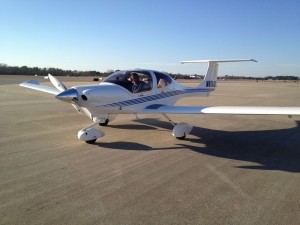 our club has just purchased a 2003 DA40, N653JS. The airplane was based at KSZF in Rhode Island and our club had arranged for some post purchase maintenance to be completed at KPGV in North Carolina. So the plan was for me to get to KSZF, receive training from an instructor to satisfy the insurance company (and to make me comfortable), and then fly N653JS to KPGV and get picked up for the ride back to our home base at KPHF. Lots of moving parts to this endeavor. I arrived in Providence, RI the night prior to the pick up and stayed at a hotel near the airport. The following morning my instructor for Diamond training, Jacob Hoffman, picked me up at 8:00 for the drive to KSZF. Jacob is an instructor for AirVentures, a flight school at KSZF. We arrived at the airport and started with a review of the manuals and then a preflight/discussion of the aircraft systems. Jacob was very knowledgeable and thorough. I was impressed with the size of the DA40. I’m 6’2″ and I thought that it would
our club has just purchased a 2003 DA40, N653JS. The airplane was based at KSZF in Rhode Island and our club had arranged for some post purchase maintenance to be completed at KPGV in North Carolina. So the plan was for me to get to KSZF, receive training from an instructor to satisfy the insurance company (and to make me comfortable), and then fly N653JS to KPGV and get picked up for the ride back to our home base at KPHF. Lots of moving parts to this endeavor. I arrived in Providence, RI the night prior to the pick up and stayed at a hotel near the airport. The following morning my instructor for Diamond training, Jacob Hoffman, picked me up at 8:00 for the drive to KSZF. Jacob is an instructor for AirVentures, a flight school at KSZF. We arrived at the airport and started with a review of the manuals and then a preflight/discussion of the aircraft systems. Jacob was very knowledgeable and thorough. I was impressed with the size of the DA40. I’m 6’2″ and I thought that it would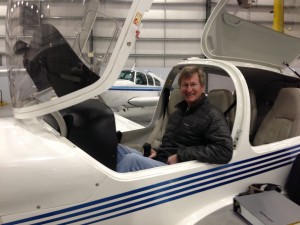 be a tight fit but I had plenty of headroom and legroom. One thing I continued to have problems with is that you enter the cockpit from the front of the wing. I’m used to getting into low-wing airplanes from behind the wing and so I kept walking around behind the wing only return to the front. I found the seats comfortable. The pilot and copilot seats are fixed and you adjust the rudder pedals fore and aft by pulling a cable. I was surprised at the legroom available for the backseat passengers. This DA40 also has a “ski” compartment in addition to the cargo area behind the rear passenger seats. This is a long “tube” that would allow you to put skis (or some such thing) in the aircraft. It is placarded with a 10 lbs max gross weight so you are not going to put much in the “ski” tube. After our preflight in hangar we got the DA40 outside and refueled. The start up is pretty straight forward and soon we were up and running. It was windy and there was a good crosswind on runway 23; a great way to learn a new airplane! Back to the rudder pedals, the pedals are close together and on each side there is a fixed metal bar (or bracket) that is
be a tight fit but I had plenty of headroom and legroom. One thing I continued to have problems with is that you enter the cockpit from the front of the wing. I’m used to getting into low-wing airplanes from behind the wing and so I kept walking around behind the wing only return to the front. I found the seats comfortable. The pilot and copilot seats are fixed and you adjust the rudder pedals fore and aft by pulling a cable. I was surprised at the legroom available for the backseat passengers. This DA40 also has a “ski” compartment in addition to the cargo area behind the rear passenger seats. This is a long “tube” that would allow you to put skis (or some such thing) in the aircraft. It is placarded with a 10 lbs max gross weight so you are not going to put much in the “ski” tube. After our preflight in hangar we got the DA40 outside and refueled. The start up is pretty straight forward and soon we were up and running. It was windy and there was a good crosswind on runway 23; a great way to learn a new airplane! Back to the rudder pedals, the pedals are close together and on each side there is a fixed metal bar (or bracket) that is 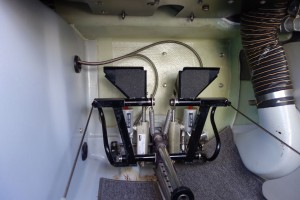 used to push the pedals to the out (away from the pilot) position. I was wearing a pair of light hiking boots (anticipating the cold weather) and my big feet came in contact with the fixed metal bar if I didn’t make sure to kept them close together. I believe the problem was my big feet combined with my boots and in the future I plan to wear a light weight pair of shoes. So, if you have big feet, be warned! After the upper air work we went to KPDV for an ILS and a few patterns. Then back to KSZF with a forced landing scenario. We ended the flight training with cross wind landings. I felt comfortable with the DA40 and Jacob was happy with me so with training completed I refueled and started on my way to North Carolina. I filed IFR at 6000′ via JFK and then down the coast to Delaware Airpark (33N) for relatively cheap fuel. ATC decided to completely change my clearance but with some knob turning I was on my way. (A hearty thank you to ForeFlight!) ATC said I had to go to 8000′ for some unknown reason and I continued at that altitude towards NYC for about 45 minutes in a >35 knot headwind. At that altitude the rpm was 2400 and the manifold press 21.3 with a OAT of +1 degrees C. Using a indicated airspeed of 130 knots I came up with a TAS of around 148 knots. ATC lowered me to
used to push the pedals to the out (away from the pilot) position. I was wearing a pair of light hiking boots (anticipating the cold weather) and my big feet came in contact with the fixed metal bar if I didn’t make sure to kept them close together. I believe the problem was my big feet combined with my boots and in the future I plan to wear a light weight pair of shoes. So, if you have big feet, be warned! After the upper air work we went to KPDV for an ILS and a few patterns. Then back to KSZF with a forced landing scenario. We ended the flight training with cross wind landings. I felt comfortable with the DA40 and Jacob was happy with me so with training completed I refueled and started on my way to North Carolina. I filed IFR at 6000′ via JFK and then down the coast to Delaware Airpark (33N) for relatively cheap fuel. ATC decided to completely change my clearance but with some knob turning I was on my way. (A hearty thank you to ForeFlight!) ATC said I had to go to 8000′ for some unknown reason and I continued at that altitude towards NYC for about 45 minutes in a >35 knot headwind. At that altitude the rpm was 2400 and the manifold press 21.3 with a OAT of +1 degrees C. Using a indicated airspeed of 130 knots I came up with a TAS of around 148 knots. ATC lowered me to 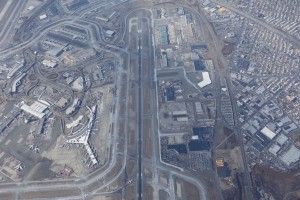 6000′ and I had a great view of JFK. I took some photos of NYC but there was a little haze and so the pictures didn’t turn out so well. ATC was not too busy and I finally turned towards the southwest and the headwind turned into a crosswind. It had been quite bumpy but I seemed to cross a cold frontal line and the turbulence had abated. I started to do a few more TAS calculations. I first used a higher power setting of 23′ manifold pressure (mp) and 2400 rpm. With a plus 3 degrees centigrade and an indicated airspeed of 130 I had a TAS 149. I was lowered again to 4000′ and adjusted to a “normal” cruise (according to the manual I was using for the DA40) of 23′ mp and 2200 rpm.
6000′ and I had a great view of JFK. I took some photos of NYC but there was a little haze and so the pictures didn’t turn out so well. ATC was not too busy and I finally turned towards the southwest and the headwind turned into a crosswind. It had been quite bumpy but I seemed to cross a cold frontal line and the turbulence had abated. I started to do a few more TAS calculations. I first used a higher power setting of 23′ manifold pressure (mp) and 2400 rpm. With a plus 3 degrees centigrade and an indicated airspeed of 130 I had a TAS 149. I was lowered again to 4000′ and adjusted to a “normal” cruise (according to the manual I was using for the DA40) of 23′ mp and 2200 rpm. 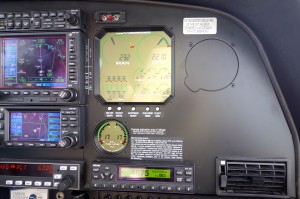 With outside temp of 8 degrees C I had a TAS of 141 knots. The aircraft really seems to be comfortable at this power setting, smooth and quiet (at least with my Lightspeed headset on). I landed at 33N and got fuel. I calculated a burn rate of 10.5 gallons an hour. I did several more TAS calculations on the second leg from 33N to KPGV and always had a TAS greater than 140 knots. Again, this DA40 is very comfortable in cruise with a 23 mp and 2200 rpm. A few of observations. This airplane has incredible visibility but you’d better wear a hat if you’re heading into the sun. The vents seemed to work well and afforded adequate ventilation however it wasn’t a warm day. Jacob said the DA40 actually wasn’t bad in
With outside temp of 8 degrees C I had a TAS of 141 knots. The aircraft really seems to be comfortable at this power setting, smooth and quiet (at least with my Lightspeed headset on). I landed at 33N and got fuel. I calculated a burn rate of 10.5 gallons an hour. I did several more TAS calculations on the second leg from 33N to KPGV and always had a TAS greater than 140 knots. Again, this DA40 is very comfortable in cruise with a 23 mp and 2200 rpm. A few of observations. This airplane has incredible visibility but you’d better wear a hat if you’re heading into the sun. The vents seemed to work well and afforded adequate ventilation however it wasn’t a warm day. Jacob said the DA40 actually wasn’t bad in 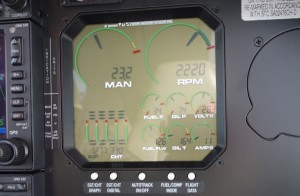 the summer once you were airborne and he has flow them for a flight school in Florida. The wings are long and low and it would be easy to taxi into something sticking up like a taxiway light or sign by a taxiway (note the photo below). Also below is a photo of the adapter plug for a iPad charger. This plug is limited to 2 amps and I plugged a iPad charger into it and it created havoc with static on the radios. It also is labeled “for ground use only” and I didn’t
the summer once you were airborne and he has flow them for a flight school in Florida. The wings are long and low and it would be easy to taxi into something sticking up like a taxiway light or sign by a taxiway (note the photo below). Also below is a photo of the adapter plug for a iPad charger. This plug is limited to 2 amps and I plugged a iPad charger into it and it created havoc with static on the radios. It also is labeled “for ground use only” and I didn’t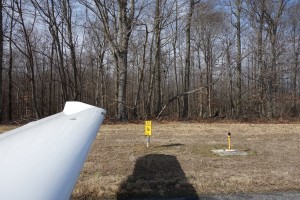 notice this until after the radio static problem. It was a long day and I was happy to finally get home at about 10:00 pm! Overall I’m happy with the DA40 and think it will be a good addition to our club.
notice this until after the radio static problem. It was a long day and I was happy to finally get home at about 10:00 pm! Overall I’m happy with the DA40 and think it will be a good addition to our club.
Mountain Flying
I’ve been doing some mountain flight training in an area southwest of Carson City, NV. Mountain flying in helicopters requires good performance planning as well as an understanding of the effects of wind, weather, and the of course the lack of O²! I currently use the ForeFlight™ app on my iPad retina mini for flight planning, en route navigation, and situational awareness. I’m a big fan of ForeFlight™; check out this screen shot. 
When you are in flight the symbol ForeFlight™ provides for your aircraft is an airplane, helicopter, or some other symbol (the symbol is user selectable). I usually use a helicopter but in this case my position is just a blue dot. This is because I’m not moving. Yep, just landed at about 11,500′. Depending on the source the highest airport in the world is in Tibet at about 14,219′ with a runway over 14,000 feet long. But 11,500′ is still pretty high. I have landed at higher elevations but this 11.5K spot is about the highest we can use in this area.
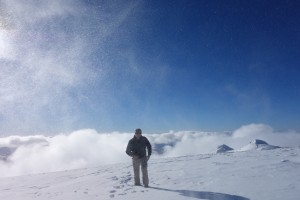 Here is a photo of one of my passengers at 11,500′. It was about -7 degrees at the time. I like to use a mountain flying technique of approaching the landing site on the windward side. This puts the helicopter in smoother up flowing air. The up flow (updraft) requires less power. I then make passes at 40 knots to discover which direction provides a headwind. I let the aircraft crab into the wind and continue into the landing site all the while keeping power applied. This technique allows the pilot to approach with power in a controlled manner while providing an escape route into the wind and up flow. Great training and great fun!
Here is a photo of one of my passengers at 11,500′. It was about -7 degrees at the time. I like to use a mountain flying technique of approaching the landing site on the windward side. This puts the helicopter in smoother up flowing air. The up flow (updraft) requires less power. I then make passes at 40 knots to discover which direction provides a headwind. I let the aircraft crab into the wind and continue into the landing site all the while keeping power applied. This technique allows the pilot to approach with power in a controlled manner while providing an escape route into the wind and up flow. Great training and great fun!
Memories
I happened upon this airplane in Yuma, AZ this week. It is the the same make, model, and year as the first airplane I soloed many years ago. This is a 1959 Cessna 150 that has been converted to a taildragger but in many ways it is identical to the one I soloed when I was 16, good old N5964E. This is even the original paint scheme used for 1959 Cessna 150s, just like the one we had, and note that the tail numbers are close (this one is N5789E). My Mom owned N5964E but unfortunately some folks managed to total it (no one was seriously hurt). Ours was a tricycle gear as were all the C-150s unless converted like this one. I didn’t meet the owner but this airplane looks to be in great shape. N5964E was a great airplane and I wish we still had her around.
(this one is N5789E). My Mom owned N5964E but unfortunately some folks managed to total it (no one was seriously hurt). Ours was a tricycle gear as were all the C-150s unless converted like this one. I didn’t meet the owner but this airplane looks to be in great shape. N5964E was a great airplane and I wish we still had her around.
Brand new web site
So this is my brand new web site. The old one was designed with the help of some person I never saw in some land far, far away. It wasn’t bad but I couldn’t edit the site. I’m not a tech guy – well I’m not a real good tech guy, (I love gadgets) but I’ve gradually learned to use WordPress and so here it is. Nothing too fancy however my intent is to get some information out about my company, On Course Aviation LLC, and WV77, our little airport in West Virginia. My blogs may be sporatic but I hope to get some comments about WV77 from those that fly there and enjoy the airport. If you have questions about flight training or other business opportunities please use the contracts page and either email or call.
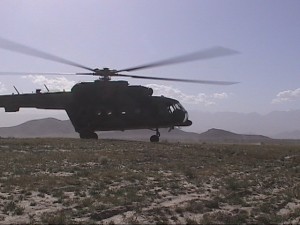 Right now I’m in Dallas for the Vintage and Experimental Aircraft Examiners annual get together with the FAA. I’m an experimental examiner for the Russian Mi-8 series of helicopters. It’s a big ugly brute but I love to fly it. Lot of good information put out today by the ladies from AFS 760. They are the paperwork folks from the FAA and it all comes down to the paperwork. I’ll be adding blog posts on all things aviation such as techniques, regulation updates, and gear I like and how I use it. Check back in when you have the time.
Right now I’m in Dallas for the Vintage and Experimental Aircraft Examiners annual get together with the FAA. I’m an experimental examiner for the Russian Mi-8 series of helicopters. It’s a big ugly brute but I love to fly it. Lot of good information put out today by the ladies from AFS 760. They are the paperwork folks from the FAA and it all comes down to the paperwork. I’ll be adding blog posts on all things aviation such as techniques, regulation updates, and gear I like and how I use it. Check back in when you have the time.

